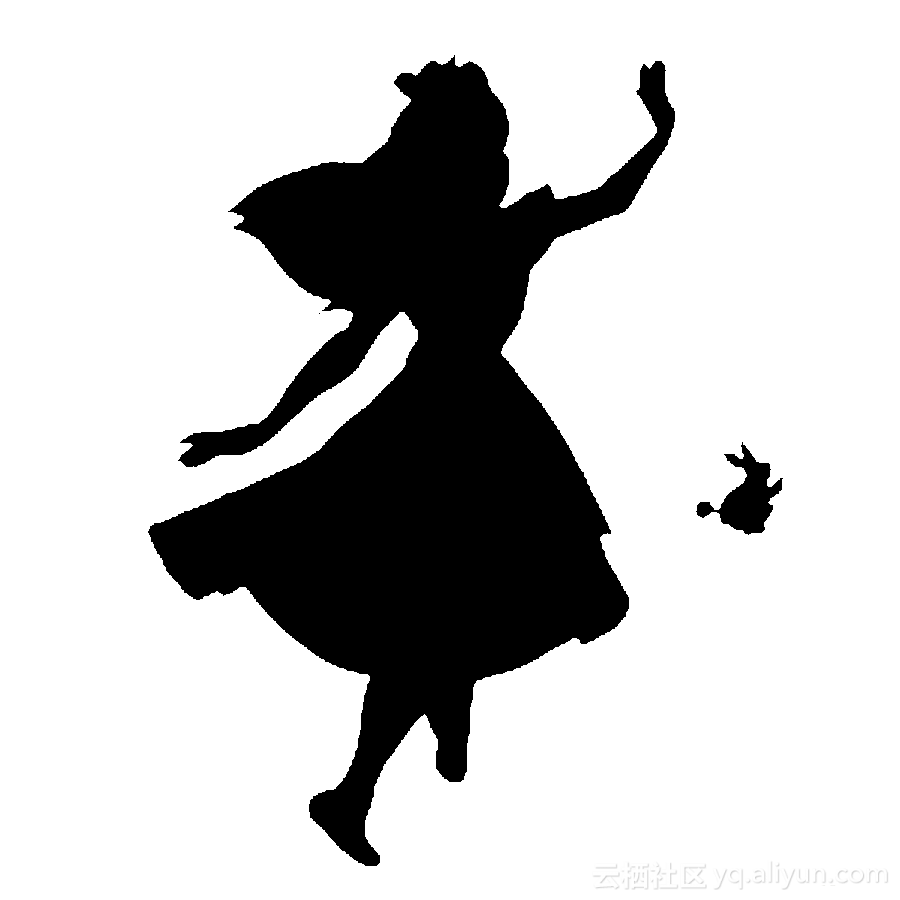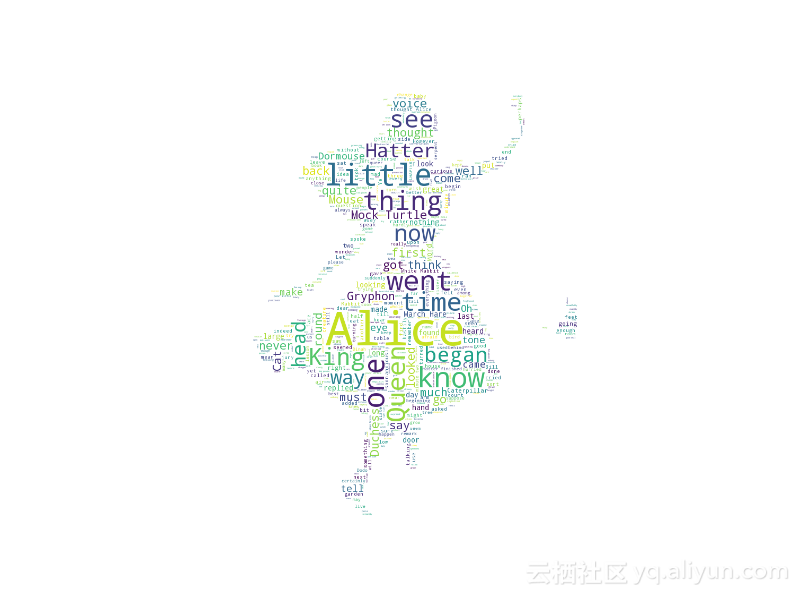python的一个蛮酷炫的功能是可以轻松地实现词云。
github上有关于这个项目的开源代码:
https://github.com/amueller/word_cloud
注意跑例程时要删除里面的wordcloud文件夹
词云的功能有部分是基于NLP,有部分是基于图像的,
下面以一段github wordcloud上面的代码为例
from os import path
from PIL import Image
import numpy as np
import matplotlib.pyplot as plt
from wordcloud import WordCloud, STOPWORDS
d = path.dirname(__file__)
# Read the whole text.
text = open(path.join(d, 'alice.txt')).read()
# read the mask image
# taken from
# http://www.stencilry.org/stencils/movies/alice%20in%20wonderland/255fk.jpg
alice_mask = np.array(Image.open(path.join(d, "alice_mask.png")))
stopwords = set(STOPWORDS)
stopwords.add("said")
wc = WordCloud(background_color="white", max_words=2000, mask=alice_mask,
stopwords=stopwords)
# generate word cloud
wc.generate(text)
# store to file
wc.to_file(path.join(d, "alice.png"))
# show
plt.imshow(wc, interpolation='bilinear')
plt.axis("off")
plt.figure()
plt.imshow(alice_mask, cmap=plt.cm.gray, interpolation='bilinear')
plt.axis("off")
plt.show()
原图:
结果:
Alice与兔子的图片
其中:
text打开文档
alice_mask是以数组的形式加载图画
stopwords设置停止显示的词语
WordCloud设置词云的属性
generate生成词云
to_file储存图片
进入wordcloud.py可以看到WordCloud类的相关属性:
"""Word cloud object for generating and drawing.
Parameters
----------
font_path : string
Font path to the font that will be used (OTF or TTF).
Defaults to DroidSansMono path on a Linux machine. If you are on
another OS or don't have this font, you need to adjust this path.
width : int (default=400)
Width of the canvas.
height : int (default=200)
Height of the canvas.
prefer_horizontal : float (default=0.90)
The ratio of times to try horizontal fitting as opposed to vertical.
If prefer_horizontal < 1, the algorithm will try rotating the word
if it doesn't fit. (There is currently no built-in way to get only vertical
words.)
mask : nd-array or None (default=None)
If not None, gives a binary mask on where to draw words. If mask is not
None, width and height will be ignored and the shape of mask will be
used instead. All white (#FF or #FFFFFF) entries will be considerd
"masked out" while other entries will be free to draw on. [This
changed in the most recent version!]
scale : float (default=1)
Scaling between computation and drawing. For large word-cloud images,
using scale instead of larger canvas size is significantly faster, but
might lead to a coarser fit for the words.
min_font_size : int (default=4)
Smallest font size to use. Will stop when there is no more room in this
size.
font_step : int (default=1)
Step size for the font. font_step > 1 might speed up computation but
give a worse fit.
max_words : number (default=200)
The maximum number of words.
stopwords : set of strings or None
The words that will be eliminated. If None, the build-in STOPWORDS
list will be used.
background_color : color value (default="black")
Background color for the word cloud image.
max_font_size : int or None (default=None)
Maximum font size for the largest word. If None, height of the image is
used.
mode : string (default="RGB")
Transparent background will be generated when mode is "RGBA" and
background_color is None.
relative_scaling : float (default=.5)
Importance of relative word frequencies for font-size. With
relative_scaling=0, only word-ranks are considered. With
relative_scaling=1, a word that is twice as frequent will have twice
the size. If you want to consider the word frequencies and not only
their rank, relative_scaling around .5 often looks good.
.. versionchanged: 2.0
Default is now 0.5.
color_func : callable, default=None
Callable with parameters word, font_size, position, orientation,
font_path, random_state that returns a PIL color for each word.
Overwrites "colormap".
See colormap for specifying a matplotlib colormap instead.
regexp : string or None (optional)
Regular expression to split the input text into tokens in process_text.
If None is specified, ``r"\w[\w']+"`` is used.
collocations : bool, default=True
Whether to include collocations (bigrams) of two words.
.. versionadded: 2.0
colormap : string or matplotlib colormap, default="viridis"
Matplotlib colormap to randomly draw colors from for each word.
Ignored if "color_func" is specified.
.. versionadded: 2.0
normalize_plurals : bool, default=True
Whether to remove trailing 's' from words. If True and a word
appears with and without a trailing 's', the one with trailing 's'
is removed and its counts are added to the version without
trailing 's' -- unless the word ends with 'ss'.
Attributes
----------
``words_`` : dict of string to float
Word tokens with associated frequency.
.. versionchanged: 2.0
``words_`` is now a dictionary
``layout_`` : list of tuples (string, int, (int, int), int, color))
Encodes the fitted word cloud. Encodes for each word the string, font
size, position, orientation and color.
Notes
-----
Larger canvases with make the code significantly slower. If you need a
large word cloud, try a lower canvas size, and set the scale parameter.
The algorithm might give more weight to the ranking of the words
than their actual frequencies, depending on the ``max_font_size`` and the
scaling heuristic.
"""其中:
font_path表示用到字体的路径
width和height表示画布的宽和高
prefer_horizontal可以调整词云中字体水平和垂直的多少
mask即掩膜,产生词云背景的区域
scale:计算和绘图之间的缩放
min_font_size设置最小的字体大小
max_words设置字体的多少
stopwords设置禁用词
background_color设置词云的背景颜色
max_font_size设置字体的最大尺寸
mode设置字体的颜色 但设置为RGBA时背景透明
relative_scaling设置有关字体大小的相对字频率的重要性
regexp设置正则表达式
collocations 是否包含两个词的搭配
在generate函数中调试进去可以看到函数:
words=process_text(text)可以返回文本中的词频
generate_from_frequencies根据单词和词频创造一个词云
下面是generate_from_frequencies函数的实现步骤
def generate_from_frequencies(self, frequencies, max_font_size=None):
"""Create a word_cloud from words and frequencies.
Parameters
----------
frequencies : dict from string to float
A contains words and associated frequency.
max_font_size : int
Use this font-size instead of self.max_font_size
Returns
-------
self
"""
# make sure frequencies are sorted and normalized
frequencies = sorted(frequencies.items(), key=item1, reverse=True)
if len(frequencies) <= 0:
raise ValueError("We need at least 1 word to plot a word cloud, "
"got %d." % len(frequencies))
frequencies = frequencies[:self.max_words]
# largest entry will be 1
max_frequency = float(frequencies[0][1])
frequencies = [(word, freq / max_frequency)
for word, freq in frequencies]
if self.random_state is not None:
random_state = self.random_state
else:
random_state = Random()
if self.mask is not None:
mask = self.mask
width = mask.shape[1]
height = mask.shape[0]
if mask.dtype.kind == 'f':
warnings.warn("mask image should be unsigned byte between 0"
" and 255. Got a float array")
if mask.ndim == 2:
boolean_mask = mask == 255
elif mask.ndim == 3:
# if all channels are white, mask out
boolean_mask = np.all(mask[:, :, :3] == 255, axis=-1)
else:
raise ValueError("Got mask of invalid shape: %s"
% str(mask.shape))
else:
boolean_mask = None
height, width = self.height, self.width
occupancy = IntegralOccupancyMap(height, width, boolean_mask)
# create image
img_grey = Image.new("L", (width, height))
draw = ImageDraw.Draw(img_grey)
img_array = np.asarray(img_grey)
font_sizes, positions, orientations, colors = [], [], [], []
last_freq = 1.
if max_font_size is None:
# if not provided use default font_size
max_font_size = self.max_font_size
if max_font_size is None:
# figure out a good font size by trying to draw with
# just the first two words
if len(frequencies) == 1:
# we only have one word. We make it big!
font_size = self.height
else:
self.generate_from_frequencies(dict(frequencies[:2]),
max_font_size=self.height)
# find font sizes
sizes = [x[1] for x in self.layout_]
font_size = int(2 * sizes[0] * sizes[1] / (sizes[0] + sizes[1]))
else:
font_size = max_font_size
# we set self.words_ here because we called generate_from_frequencies
# above... hurray for good design?
self.words_ = dict(frequencies)
# start drawing grey image
for word, freq in frequencies:
# select the font size
rs = self.relative_scaling
if rs != 0:
font_size = int(round((rs * (freq / float(last_freq))
+ (1 - rs)) * font_size))
if random_state.random() < self.prefer_horizontal:
orientation = None
else:
orientation = Image.ROTATE_90
tried_other_orientation = False
while True:
# try to find a position
font = ImageFont.truetype(self.font_path, font_size)
# transpose font optionally
transposed_font = ImageFont.TransposedFont(
font, orientation=orientation)
# get size of resulting text
box_size = draw.textsize(word, font=transposed_font)
# find possible places using integral image:
result = occupancy.sample_position(box_size[1] + self.margin,
box_size[0] + self.margin,
random_state)
if result is not None or font_size < self.min_font_size:
# either we found a place or font-size went too small
break
# if we didn't find a place, make font smaller
# but first try to rotate!
if not tried_other_orientation and self.prefer_horizontal < 1:
orientation = (Image.ROTATE_90 if orientation is None else
Image.ROTATE_90)
tried_other_orientation = True
else:
font_size -= self.font_step
orientation = None
if font_size < self.min_font_size:
# we were unable to draw any more
break
x, y = np.array(result) + self.margin // 2
# actually draw the text
draw.text((y, x), word, fill="white", font=transposed_font)
positions.append((x, y))
orientations.append(orientation)
font_sizes.append(font_size)
colors.append(self.color_func(word, font_size=font_size,
position=(x, y),
orientation=orientation,
random_state=random_state,
font_path=self.font_path))
# recompute integral image
if self.mask is None:
img_array = np.asarray(img_grey)
else:
img_array = np.asarray(img_grey) + boolean_mask
# recompute bottom right
# the order of the cumsum's is important for speed ?!
occupancy.update(img_array, x, y)
last_freq = freq
self.layout_ = list(zip(frequencies, font_sizes, positions,
orientations, colors))
return self比较遗憾的词云并没有用到opencv库,如果用到opencv库应该可以做到更加炫酷
接下来可能想加上Opencv等工具来处理词云中较为不足的地方




